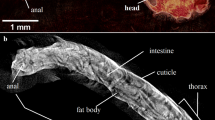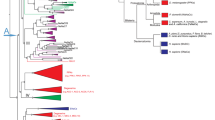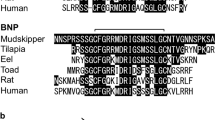Abstract
Metapenæus monoceros is a widely distributed Indo-Pacific prawn often met with in shores and estuaries liable to great variations in salinity. At Madras, it is a common inhabitant of the saline part of the Adyar and Cooum Rivers, and sexually mature as well as post-larval prawns have been obtained in brackish water1. Dakin2 has recently reported that the Australian species of Metapenæus, which is usually known under the name M. monoceros but is believed to be different, breeds in the coastal lakes and estuaries unlike other Penseids. As part of a programme of study on the osmotic regulation in Penæid prawns, we have recently examined the changes in the chloride content of blood in this prawn by employing the micro-modification of the Volhard titration as described by Wigglesworth3. The results obtained appear to be of considerable interest since powers of active regulation of chloride are developed to a very high degree in this prawn (see graph).
This is a preview of subscription content, access via your institution
Access options
Subscribe to this journal
Receive 51 print issues and online access
$199.00 per year
only $3.90 per issue
Buy this article
- Purchase on Springer Link
- Instant access to full article PDF
Prices may be subject to local taxes which are calculated during checkout
Similar content being viewed by others
References
Panikkar, N. K., and Aiyar, R. G., Proc. Indian Acad. Sci., B, 9, 343 (1939).
Dakin, W. J., Nature, 158, 99 (1946).
Wigglesworth, V. B., Biochem. J., 31, 719 (1938).
Krogh, A., "Osmotic Regulation in Aquatic Animals" (Cambridge Univ. Press, 1939).
Beadle, L. C., and Cragg, J. B., J. Exp. Biol, 17, 437 (1940).
Scholles, W., Z. vergl. Physiol, 19, 522 (1933).
Panikkar, N. K., J. Mar. Biol. Assoc. 25, 317 (1941).
Brockema, M. M., Thesis, Groningen (1941).
Author information
Authors and Affiliations
Rights and permissions
About this article
Cite this article
PANIKKAR, N., VISWANATHAN, R. Active Regulation of Chloride in Metapenæus monoceros Fabricius. Nature 161, 137–138 (1948). https://doi.org/10.1038/161137a0
Issue Date:
DOI: https://doi.org/10.1038/161137a0
This article is cited by
-
The influence of rainfall on the distribution and abundance of the school prawn Metapenaeus macleayi in the Hunter River region (Australia)
Marine Biology (1973)
-
Influence of salinity and temperature on the oxygen consumption in young juveniles of the Indian prawn Penaeus indicus
Marine Biology (1971)
-
Changes in volume of a brackish water prawn in different media
Proceedings / Indian Academy of Sciences (1966)
-
Physiologische und ökologische Aspekte des Lebens in Ästuarien
Helgoländer Wissenschaftliche Meeresuntersuchungen (1964)
-
Osmoregulation inClibanarius padavensis de man, under heterosmotic conditions
Proceedings / Indian Academy of Sciences (1961)
Comments
By submitting a comment you agree to abide by our Terms and Community Guidelines. If you find something abusive or that does not comply with our terms or guidelines please flag it as inappropriate.



